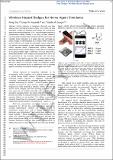Wireless Hazard Badges to Detect Nerve-Agent Simulants
Author(s)
Zhu, Rong; Azzarelli, Joseph M.; Swager, Timothy M
DownloadANIE-S-16-04880.pdf (1.297Mb)
OPEN_ACCESS_POLICY
Open Access Policy
Creative Commons Attribution-Noncommercial-Share Alike
Terms of use
Metadata
Show full item recordAbstract
Human exposure to hazardous chemicals can have adverse short- and long-term health effects. In this Communication, we have developed a single-use wearable hazard badge that dosimetrically detects diethylchlorophosphate (DCP), a model organophosphorous cholinesterase inhibitor simulant. Improved chemically actuated resonant devices (CARDs) are fabricated in a single step and unambiguously relate changes in chemiresistance to a wireless readout. To provide selective and readily manufacturable sensor elements for this platform, we developed an ionic-liquid-mediated single walled carbon nanotube based chemidosimetric scheme with DCP limits of detection of 28 ppb. As a practical demonstration, an 8 h workday time weighted average equivalent exposure of 10 ppb DCP effects an irreversible change in smartphone readout. Keywords: carbon nanotubes; dosimeter; ionic liquids; nerve agents; sensors
Date issued
2016-07Department
Massachusetts Institute of Technology. Institute for Soldier Nanotechnologies; Massachusetts Institute of Technology. Department of ChemistryJournal
Angewandte Chemie International Edition
Publisher
Wiley Blackwell
Citation
Zhu, Rong, et al. “Wireless Hazard Badges to Detect Nerve-Agent Simulants.” Angewandte Chemie International Edition, vol. 55, no. 33, Aug. 2016, pp. 9662–66.
Version: Author's final manuscript
ISSN
1433-7851
1521-3773